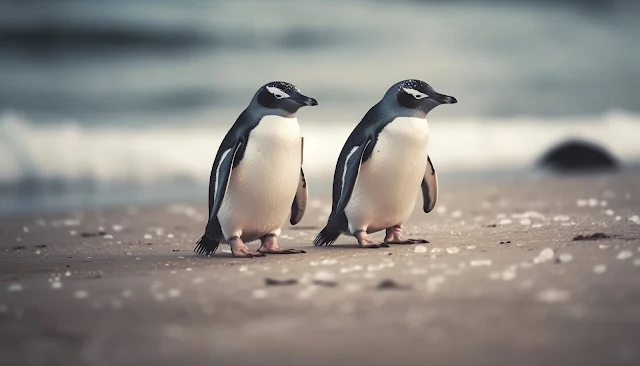Penguins, the charismatic flightless birds of the Southern Hemisphere, have long captivated the creativeness of human beings with their high-quality variations in extreme environments. From the icy nation-states of Antarctica to the temperate waters of coastal regions, penguins have evolved special techniques to thrive in various ecosystems. In this essay, we delve into the secrets of penguin survival, exploring how these fascinating creatures navigate the challenges of their habitats, from icy landscapes to open oceans.
Adaptations to Ice:
The Antarctic continent, with its tremendous expanses of ice and frigid temperatures, provides an ambitious environment for life. Yet penguins have efficiently colonized these inhospitable lands, thanks to a suite of adaptations tailor-made for survival in icy conditions. One of the most important features of penguins is their plumage, which acts as both insulation and waterproofing. A dense layer of down feathers traps air close to the body, presenting a high-quality barrier in opposition to the cold, while specialized oil glands help repel water, retaining the birds dry even when swimming in freezing seas.
Beyond their physical attributes, penguins have also developed unique behaviors to cope with the challenges of living on ice. Emperor penguins, for example, undertake epic journeys throughout treacherous ice floes to attain their breeding colonies, relying on an aggregate of keen navigational skills and teamwork to navigate the frozen landscape. By huddling together in tightly packed groups, they decrease warmth loss and maximize their chances of survival in the harsh Antarctic winter.
Feeding Strategies:
While ice serves as an indispensable habitat for many penguin species, it additionally presents challenges when it comes to discovering food. In the frigid waters surrounding Antarctica, penguins should dive to terrific depths in search of prey, often braving sub-zero temperatures and evading predators such as leopard seals and killer whales. To thrive in this challenging environment, penguins have developed specialized variations for looking underwater.
One such adaptation is the streamlined form of their bodies, which allows them to go through the water with magnificent agility and efficiency. Penguins use their effective flippers to propel themselves through the icy depths, while their eager eyesight helps them spot prey even in mild conditions. Some species, like the chinstrap penguin, use cooperative searching strategies, herding schools of fish into tight formations before launching coordinated assaults to capture their prey.
Migration and Navigation:
Despite their affinity for icy habitats, not all penguin species are confined to polar regions. Many species undertake lengthy migrations, visiting heaps of kilometers every year in search of meals and suitable breeding sites. These epic journeys regularly take penguins a long way from their domestic colonies, exposing them to a variety of environmental dangers along the way.
To navigate these extensive expanses of ocean, penguins rely on a mixture of innate instincts and environmental cues. Recent research suggests that they may also use the Earth's magnetic field to orient themselves at some point of migration, allowing them to navigate with top-notch precision across featureless stretches of open water. Additionally, penguins are highly sensitive to adjustments in ocean currents and temperature, which can influence the distribution of their prey and inform their movements across the seas.
Challenges and Conservation:
Despite their superadaptations, penguins face a developing array of threats in the modern world. Climate change, habitat destruction, overfishing, and pollution pose enormous challenges to penguin populations, pushing many species toward the brink of extinction. Rising temperatures and melting sea ice disrupt the delicate balance of Antarctic ecosystems, making it tougher for penguins to find food and increasing their mortality.
In addition to environmental pressures, penguins also face direct threats from human activities, such as oil spills, fishing nets, and tourism. Oil pollution, in particular, can have devastating outcomes for penguin populations, destroying their waterproofing and leading to hypothermia and death. Furthermore, disturbances precipitated by vacationers can disrupt breeding colonies and stress penguins, affecting their reproductive success and long-term survival.
To tackle these challenges, conservation efforts are underway to defend penguin habitats and mitigate the impacts of human activities on these iconic birds. Marine protected areas have been established to guard key feeding grounds and breeding colonies, while measures to limit bycatch and modify fishing activities have the intention of limiting their effects on penguin populations. Public recognition campaigns and ecotourism initiatives also play a critical role in raising awareness about the plight of penguins and merchandising sustainable practices to ensure their survival for future generations.
Conclusion:
Penguins are brilliant creatures, perfectly tailored to thrive in some of the most severe environments on Earth. From the icy wastes of Antarctica to the massive expanse of the open ocean, they have evolved a numerous array of diversifications and behaviors to cope with the challenges of their habitats. Yet, in the face of developing threats from human activities and climate change, their survival hangs in the balance. By appreciating the secrets and techniques of penguin survival and taking motion to guard their fragile ecosystems, we can make certain that these liked birds continue to enchant and inspire us for generations to come.
Penguin

